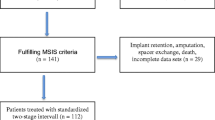Abstract
Background
Two-stage exchange arthroplasty is the gold standard for treatment of infected TKA. The erythrocyte sedimentation rate (ESR), C-reactive protein (CRP), and synovial fluid white blood cell (WBC) count with differential are often used to determine treatment response; however, it is unclear whether these tests can answer the critical question of whether joint sepsis has been controlled between stages and if reimplantation is indicated.
Questions/purposes
We therefore asked if (1) these serologies respond between stage one explantation and stage two reimplantation during two-stage knee reconstruction for infection; and (2) changes in the values of these serologies are predictive of resolution of joint infection.
Methods
We retrospectively reviewed the serologies of 76 infected patients treated with a two-stage exchange protocol. The ESR, CRP, and aspiration were repeated a minimum of 2 weeks following antibiotic cessation and prior to second stage reoperation. Comparisons were made to identify trends in these serologies between the first and second stage procedures.
Results
Eight knees (12%) were persistently infected at the time of second stage reoperation. The ESR remained persistently elevated in 37 knees (54%), and the CRP remained elevated in 14 knees (21%) where infection had been controlled. We were unable to identify an optimum cutoff value for the ESR, CRP, or the two combined. The best test for confirmation of infection control was the synovial fluid WBC count.
Conclusions
Although the ESR, CRP, and synovial fluid WBC counts decreased in cases of infection control, these values frequently remained elevated. We were unable to identify any patterns in these tests indicative of persistent infection.
Level of Evidence
Level II, diagnostic study. See Guidelines for Authors for a complete description of levels of evidence.

Similar content being viewed by others
References
Austin MS, Ghanem E, Joshi A, Lindsay A, Parvizi J. A simple, cost-effective screening protocol to rule out periprosthetic infection. J Arthroplasty. 2008;23:65–68.
Della Valle CJ, Bogner E, Desai P, Lonner JH, Adler E, Zuckerman JD, Di Cesare PE. Analysis of frozen sections of intraoperative specimens obtained at the time of reoperation after hip or knee resection arthroplasty for the treatment of infection. J Bone Joint Surg Am. 1999;81:684–689.
Della Valle CJ, Sporer SM, Jacobs JJ, Berger RA, Rosenberg AG, Paprosky WG. Preoperative testing for sepsis before revision total knee arthroplasty. J Arthroplasty. 2007;22(6 Suppl 2):90–93.
Fehring TK, Odum S, Calton TF, Mason JB. Articulating versus static spacers in revision total knee arthroplasty for sepsis. The Ranawat Award. Clin Orthop Relat Res. 2000;380:9–16.
Feldman DS, Lonner JH, Desai P, Zuckerman JD. The role of intraoperative frozen sections in revision total joint arthroplasty. J Bone Joint Surg Am. 1995;77:1807–1813.
Ghanem E, Azzam K, Seeley M, Joshi A, Parvizi J. Staged revision for knee arthroplasty infection: what is the role of serologic tests before reimplantation? Clin Orthop Relat Res. 2009;467:1699–1705.
Haleem AA, Berry DJ, Hanssen AD. Mid-term to long-term followup of two-stage reimplantation for infected total knee arthroplasty. Clin Orthop Relat Res. 2004;428:35–39.
Hanssen AD, Spangehl MJ. Practical applications of antibiotic-loaded bone cement for treatment of infected joint replacements. Clin Orthop Relat Res. 2004;427:79–85.
Jacofsky DJ, Hanssen AD. The infected total knee arthroplasty. In: Barrack RL, Booth RE, Lonner JH, eds. Orthopaedic Knowledge Update: Hip and Knee Reconstruction 3. Rosemont, IL: AAOS; 2006:177–183.
Lin J, Yang X, Bostrom MP. Two-stage exchange hip arthroplasty for deep infection. J Chemother. 2001;13:54–65.
Lonner JH, Siliski JM, Della Valle C, DiCesare P, Lotke PA. Role of knee aspiration after resection of the infected total knee arthroplasty. Am J Orthop. 2001;30:305–309.
Meek RM, Masri BA, Dunlop D, Garbuz DS, Greidanus NV, McGraw R, Duncan CP. Patient satisfaction and functional status after treatment of infection at the site of a total knee arthroplasty with use of the PROSTALAC articulating spacer. J Bone Joint Surg Am. 2003;85:1888–1892.
Mont MA, Waldman BJ, Hungerford DS. Evaluation of preoperative cultures before second-stage reimplantation of a total knee prosthesis complicated by infection. A comparison-group study. J Bone Joint Surg Am. 2000;82:1552–1557.
Schinsky MF, Della Valle CJ, Sporer SM, Paprosky WG. Perioperative testing for joint infection in patients undergoing revision total hip arthroplasty. J Bone Joint Surg Am. 2008;90:1869–1875.
Spangehl MJ, Masri BA, O’Connell JX, Duncan CP. Prospective analysis of preoperative and intraoperative investigations for the diagnosis of infection at the sites of two hundred and two revision total hip arthroplasties. J Bone Joint Surg Am. 1999;81:672–683.
Trampuz A, Hanssen AD, Osmon DR, Mandrekar J, Steckelberg JM, Patel R. Synovial fluid leukocyte count and differential for the diagnosis of prosthetic knee infection. Am J Med. 2004;117:556–562.
Wolff LH 3rd, Parvizi J, Trousdale RT, Pagnano MW, Osmon DR, Hanssen AD, Haidukewych GJ. Results of treatment of infection in both knees after bilateral total knee arthroplasty. J Bone Joint Surg Am. 2003;85:1952–1955.
Author information
Authors and Affiliations
Corresponding author
Additional information
Each author certifies that he or she has no commercial associations (eg, consultancies, stock ownership, equity interest, patent/licensing arrangements, etc) that might pose a conflict of interest in connection with the submitted article.
Each author certifies that his or her institution approved the human protocol for this investigation and that all investigations were conducted in conformity with ethical principles of research, and that informed consent for participation in the study was obtained.
This work was performed at the Rush University Medical Center, Chicago, IL.
About this article
Cite this article
Kusuma, S.K., Ward, J., Jacofsky, M. et al. What is the Role of Serological Testing Between Stages of Two-stage Reconstruction of the Infected Prosthetic Knee?. Clin Orthop Relat Res 469, 1002–1008 (2011). https://doi.org/10.1007/s11999-010-1619-7
Published:
Issue Date:
DOI: https://doi.org/10.1007/s11999-010-1619-7




